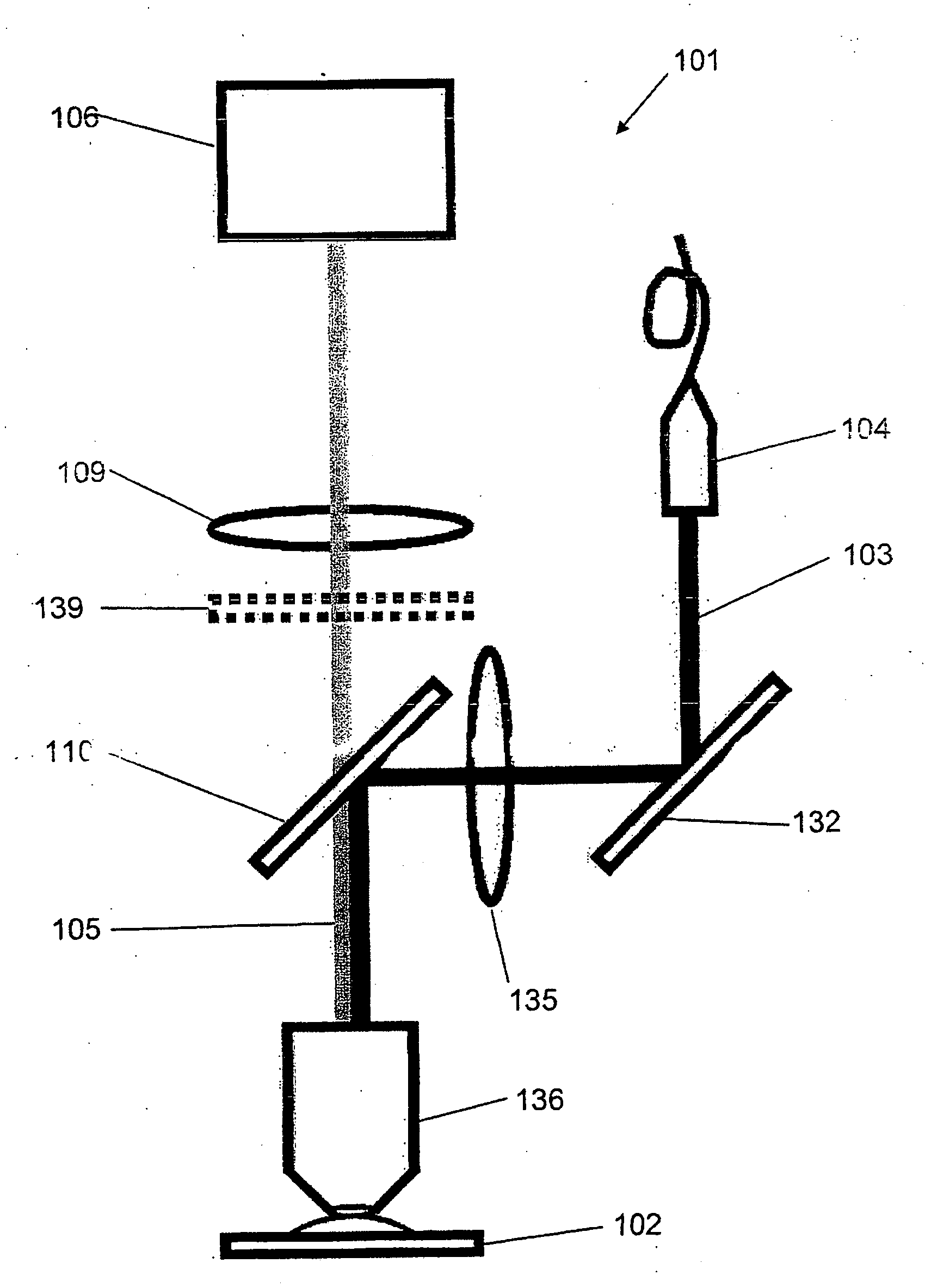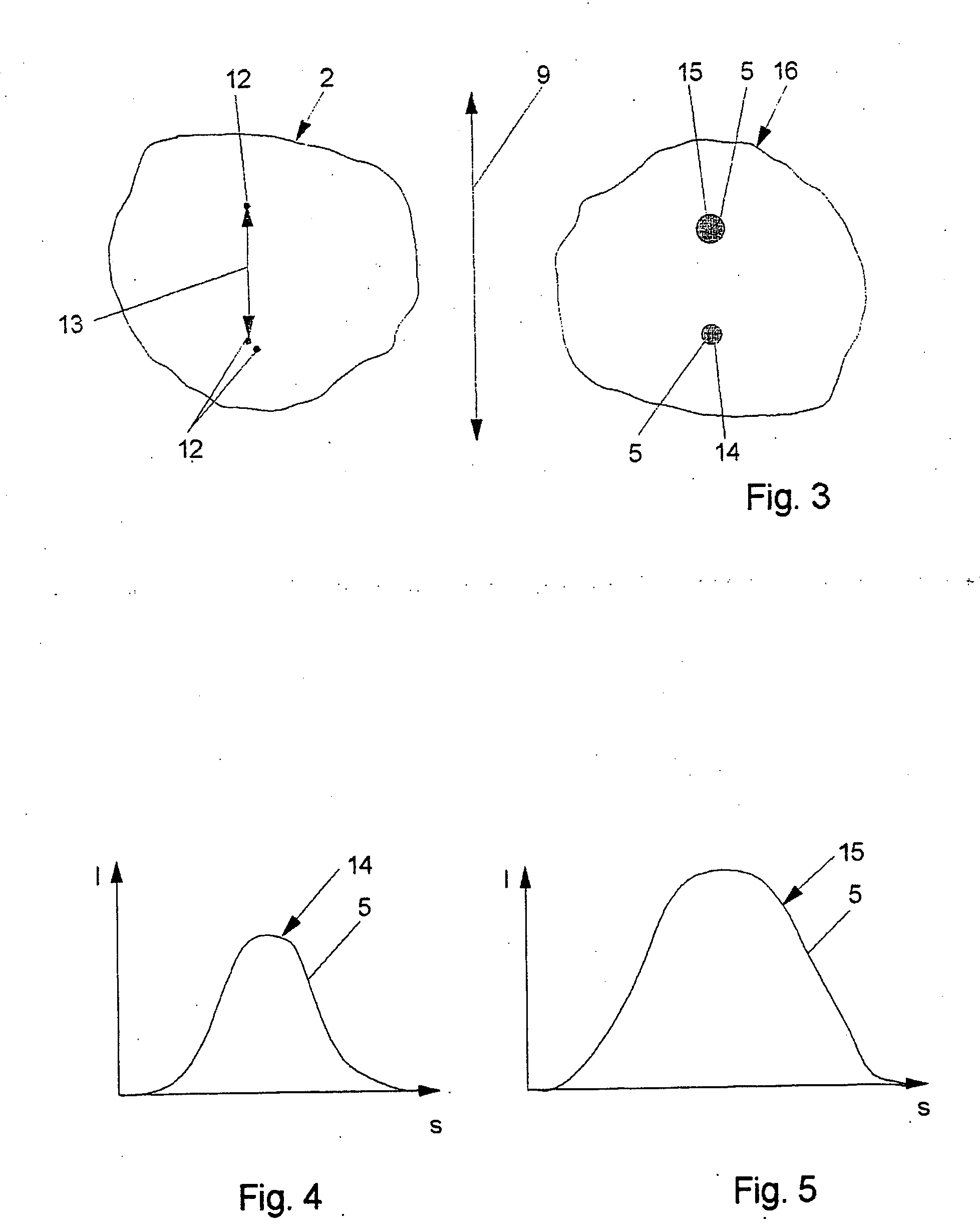[0016]In order to be able to determine the placement of the molecule in the specimen from the intensity distribution over the
sensor array of the measurement
signal coming from a molecule of the substance in the first state, with a
position resolution higher than the spatial resolution limit of the imaging of the specimen onto the sensor array, it is to be understood that the grid dimension of the pixels of the sensor array must at least be smaller than the spatial resolution limit times the imaging factor of the imaging. The greater
dimensioning is preferably only at most half as great as the spatial resolution limit times the imaging factor of the imaging, so that the measurement
signal coming from a molecule is distributed over at least four pixels of the sensor array. A much smaller grid dimension of the pixels of the sensor array is not associated with a corresponding increase in the
position resolution when determining the placement of the molecules in the specimen. Rather, it entails the risk that the
signal-to-
noise ratio will become significantly worse. A grid dimension which lies between 60 and 10% of the spatial resolution limit times the imaging factor of the imaging will therefore generally be most favorable.
[0021]The substance may furthermore be selected from a subgroup of substances which can be converted from the second state back into the first state by an optical switchback signal. In this case, before converting another fraction of the substance into the second state by the
switching signal, the fraction of the substance previously converted into the second state may deliberately be converted back into the first state by the switchback signal. It is not therefore necessary to wait for the time taken by the molecules of the substance to return from the second state into the first state, for example owing to thermal excitation or under the effect of the optical
excitation signal, which is primarily intended here for the
spontaneous emission of fluorescent light. If the half-life of the molecules of the substance in the second state has a favorable
order of magnitude, however, then the new method may also be carried out very effectively when the substance is not
convertible from the second state back into the first state by an optical switchback signal.
[0025]The total time required for imaging the structure of interest in a specimen can be shortened by carrying out the new method in parallel with at least two different substances, from which distinguishable optical measurement signals come in their respective first state. The speed of the new method is limited by the fact that the density of the molecules of the substance in the first state which lie at a sufficient distance from one another, and therefore the number of molecules whose locations can be determined in a cycle of the new method, is naturally restricted. So long as the optical measurement signals of two different substances marking the structure of interest differ so that they can be mutually separated, by using such different substances the number of molecules whose locations can be determined in a cycle of the new method can be increased proportionally to the number of different substances.
[0029]It is extremely surprising that even though it has essentially the same procedure as the method described as PALMIRA, the method of the second aspect of-the invention makes do without switchable proteins or fluorophores. Instead, as a fluorescent dye in the new method, a substance may be used in which the first and second states are different
electronic states of the substance, i.e. states of the substance which differ from one another only in electronic terms. The substance then does not fall within the definitions of the substance used for the marking in US 2004 / 0212799 A1 and US 2006 / 0038993 A1, and it may be any conventional non-switchable fluorescent dye. Besides their electronic
ground state from which they can be excited into
fluorescence, practically all conventional fluorescent dyes have an electronic
dark state into which they can be converted at a relevant rate owing to excitation with light of the same
wavelength as can be used to excite the
fluorescence. These are generally a
singlet state as the fluoresceable
ground state and a
triplet state as the
dark state. In normal fluorescent light
microscopy, the fractional conversion of a fluorescent dye into its nonfluorescent
triplet state instead of its
excited singlet state—especially with high intensities of the excitation light—is known as a
disadvantage because it reduces the yield of fluorescent light from a specimen. In the present invention, this effect is specifically utilized because the position of any individual molecule of the substance, with which the structure of interest in the specimen is marked, be recorded with a resolution better than the
diffraction limit only when the fluorescent light from the molecule can be registered in isolation, i.e. separately from the fluorescent light of neighboring molecules. To this end, only few of the molecules should respectively be in the first state.
[0030]In the new method of the second aspect of the present invention, it is frequently advantageous to implement measures which modify the lifetime of the nonfluorescent second state of the fluorescent dye in the specimen. In contrast to conventional fluorescence
microscopy, however, this often involves not extending but shortening the lifetime of the nonfluorescent second state. The measures which cause such shortening of the lifetime include cooling the specimen to low temperatures at which thermal excitations are reduced to collision-induced transitions, reducing the concentration in the specimen of
oxygen which quenches the
triplet state of the fluorescent dye, for example with a
glucose oxidase which binds
oxygen or by measurements in a vacuum, or fixing or embedding the specimen in polymers, for example PVA. The increased lifetime of the nonfluorescent second state makes it possible to keep large fractions of the fluorescent dye in the nonfluorescent second state even with lower intensities of the light of the first
wavelength.
[0040]The new method is particularly well suited for marking the specimen's structure of interest with the non-switchable fluorophores by modifying a
biological specimen with
gene technology so that it itself expresses the non-switchable fluorescent dyes or specific binding sites for the non-switchable fluorescent dyes or for linkers coupled thereto. The structure of interest in the specimen is particularly advantageously marked in this way with non-switchable organic dyes via so-called small labels or self-labeling
protein tags such as FlAsh, snap tags or halo tags. These and similar concepts are fundamentally known to the person skilled in the art, see for example http: / / www.promega.com / cnotes / cn011 / cn011—02.htm or http: / / www.covalys.com / or BioForum Europe 6, 51-59 (2005). This makes it possible to image proteins in a
biological specimen with
high resolution using widespread conventional fluorescent dyes.
 Login to View More
Login to View More 


